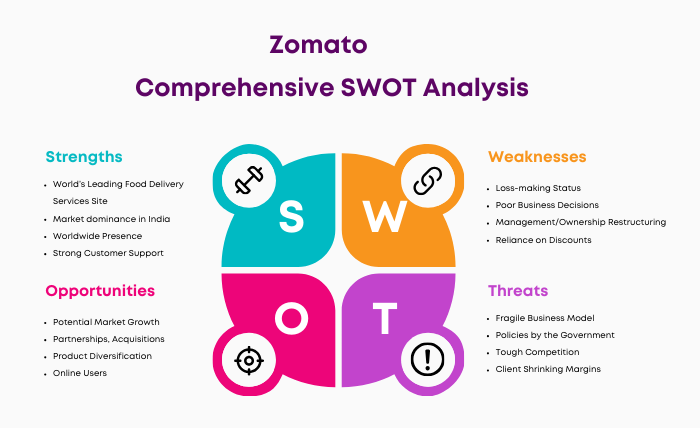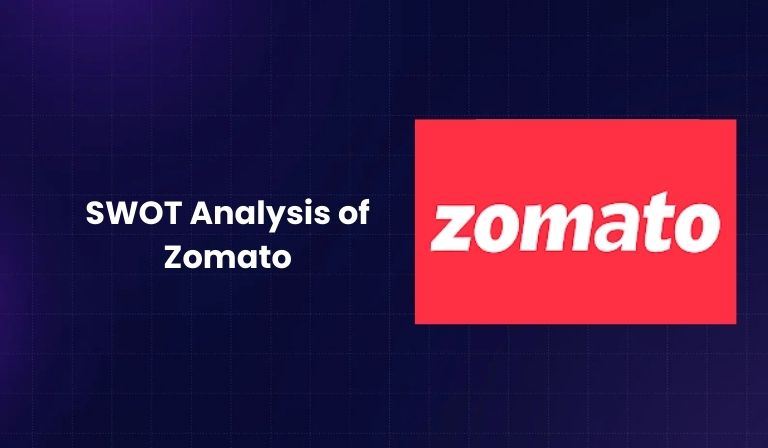Zomato, a leading name in the restaurant search and food delivery service industry, has become an integral part of the food tech landscape in India and across several international markets. From its humble beginnings in 2008, Zomato has grown into a global player, revolutionizing the way people discover and order food.
With its extensive database of restaurants, user-generated reviews, and seamless food ordering system, Zomato continues to innovate and evolve in the highly competitive online food delivery sector. In this updated SWOT analysis for 2025, we will delve into Zomato’s strengths, weaknesses, opportunities, and threats.

Strengths of Zomato
1. World’s Leading Food Delivery Services Site
Zomato has successfully carved out a dominant position in the global food delivery market. With 19 million average monthly transacting clients and 6.4 million active customers on its quick commerce platform, Zomato is now a global food delivery giant. It operates in over 26 countries, partnering with 226,000+ eateries and 350,000+ delivery partners to ensure a smooth and efficient delivery service. The variety of cuisines offered and the user-friendly interface have made Zomato the go-to app for foodies around the world. This extensive network allows Zomato to provide seamless service and satisfy customer tastes globally.
2. Market Dominance in India
In India, Zomato and its primary competitor Swiggy dominate the food delivery market. Zomato has recently captured 55% of the market share, making it a market leader. This dominance is a result of Zomato’s deep understanding of Indian consumer behavior, efficient operational strategies, and customer-centric approach. With personalized features, easy payment options, and continuous improvements to the delivery service, Zomato has managed to outperform its competitors, solidifying its leadership position in India.
3. Worldwide Presence
Zomato’s global reach across continents like Brazil, Turkey, New Zealand, and South Africa highlights the company’s ambition to provide diverse dining options to people worldwide. Its presence in both bustling metropolitan cities and serene regions showcases its ability to transcend geographical and cultural boundaries, offering a wide array of cuisines to millions of consumers in different regions. By expanding to various parts of the world, Zomato continues to meet diverse culinary preferences and tastes.
4. Strong Customer Support
Customer satisfaction is at the core of Zomato’s business. The company’s investment in an intelligent chatbot system and 24/7 support team ensures that customer inquiries and complaints are addressed promptly and effectively. Zomato’s commitment to providing excellent customer service builds customer loyalty and enhances its brand reputation, which is crucial in an industry where customer expectations are continually rising.
5. Rapid Growth
Zomato has experienced remarkable growth over the years, especially in its B2C businesses like food delivery, quick commerce, and dining out. In FY24, Zomato’s Gross Order Value (GOV) grew by 51% YoY, reflecting the increasing demand for its services. Hyperpure, Zomato’s food ingredient business, also saw a 99% YoY growth, contributing to the overall expansion. This consistent growth showcases Zomato’s ability to scale operations quickly and adapt to the evolving food delivery landscape.
6. Dynamic Marketing Strategies
Zomato’s marketing strategies effectively combine digital and offline efforts, helping it expand its global presence and engage a large audience. Through clever campaigns, influencer partnerships, and social media engagements, Zomato has consistently increased its brand visibility. In FY2024, Zomato attracted over 25 million new customers, underlining the effectiveness of its marketing tactics. With 9.7 million Instagram followers, 74.7K Twitter followers, and 1.9 million Facebook followers, Zomato’s digital marketing efforts continue to drive significant growth and brand recognition.
7. Diverse Offerings
Zomato’s ability to diversify its offerings beyond food delivery is a key strength. The company provides table reservations, restaurant ratings, online ordering, and even grocery delivery services. This diverse portfolio helps Zomato meet the evolving needs of customers, broadening its customer base and driving incremental growth.
8. Innovation in Digital Payments
Zomato’s Zomato Payments initiative is a strategic move into the digital payments space, offering secure and easy transactional experiences. This venture into fintech allows Zomato to enhance customer convenience, streamline transactions, and position itself as a pioneer in digital meal delivery payments, further differentiating the brand from competitors.
9. Ability to Raise Capital
Zomato’s successful $12 billion IPO in July 2021 and subsequent funding rounds from Temasek, Kora Investments, and Tiger Global Management showcase the trust investors have in its business model and growth potential. This strong financial backing gives Zomato the resources to expand its operations, invest in innovative technologies, and compete aggressively in the global food delivery market.
10. Strategic Acquisitions
Zomato’s acquisitions of companies like Uber Eats India and Blinkit, along with investments in Grofers and Curefit, reflect its strategic approach to expansion. These acquisitions not only enhance Zomato’s service offerings but also reduce competition, further solidifying its market position and increasing its consumer reach.
Weaknesses of Zomato
1. Loss-Making Status
Despite its rapid growth, Zomato continues to operate in a loss-making model, a common challenge for many food delivery services. Zomato’s net loss in FY22 surged by 50%, raising concerns among investors about the company’s profitability. The narrow profit margins typical in the food delivery industry make it difficult for Zomato to achieve consistent profitability, which could affect its long-term sustainability if not addressed.
2. Poor Business Decisions
Zomato’s strategic errors, such as aggressive discounting tactics that alienated restaurant partners, reflect its occasional missteps. The company’s 2020 foray into alcohol and grocery delivery also proved unscalable, highlighting the risks of expanding into unfamiliar markets without adequate market research or testing. These decisions have raised doubts about Zomato’s ability to effectively execute long-term strategies.
3. Management/Ownership Restructuring
Zomato faced a leadership crisis when co-founder Pankaj Chaddah suddenly departed in April 2020. High-profile exits can cause instability in strategic direction, affecting both investor and employee confidence. Given that Zomato is a fast-evolving company, steady leadership is critical to its success in such a competitive industry.
4. Reliance on Discounts
Zomato’s extensive reliance on discounts to attract and retain customers has a negative impact on both profitability and service quality. While discounts help drive sales, they also condition customers to expect lower prices, which can diminish brand value and loyalty. Additionally, this reliance on discounts leads to price wars, further squeezing profit margins.
5. Limited Geographic Reach
Compared to global competitors like Uber Eats and DoorDash, Zomato’s geographic reach is relatively limited, operating in just 10 countries. This restriction poses a challenge in terms of expanding its customer base and achieving economies of scale. Zomato faces regulatory challenges, food safety requirements, and market-specific barriers that may limit its global competitiveness.
6. Impact of Reviews on Growth
Customer reviews play a significant role in shaping Zomato’s reputation, but negative reviews can have a substantial impact. Negative feedback about restaurants or delivery services can tarnish Zomato’s reputation, even though the issues may stem from third-party restaurants rather than the platform itself. Managing reviews and ensuring consistent service quality are key challenges for Zomato.
7. Operational Challenges
Zomato faces operational inefficiencies, such as delayed deliveries, food quality issues, and logistical problems, which can affect customer satisfaction. As the company scales, these challenges could become more pronounced, further hindering Zomato’s ability to provide a seamless service experience for its growing customer base.
Opportunities for Zomato
1. Potential Market Growth
The global food delivery market is projected to reach $110 billion by 2025, with Indian food delivery expected to grow at a 28.13% CAGR. This massive growth presents an enormous opportunity for Zomato to capture a larger market share and expand its presence both in India and internationally.
2. Partnerships and Acquisitions
Zomato has earmarked $1.2 billion for strategic partnerships and acquisitions to further its growth. This funding allows Zomato to diversify its service offerings, expand its market presence, and enhance its technological capabilities, positioning the company for long-term success.
3. Product Diversification
Zomato can expand into nutritional food and health-focused products to cater to the growing demand for healthy eating options. With India’s increasing health-conscious population, Zomato has an opportunity to tap into this new market segment and create new revenue streams.
4. Growth in Online Users
The rise in smartphone and internet usage globally provides Zomato with a growing audience for its services. The digital shift, accelerated by the pandemic, means that more people are comfortable with online food ordering, giving Zomato an expanding user base to target.
5. Focus on Sustainability
Zomato has the opportunity to become a leader in sustainable food delivery by promoting eco-friendly practices among restaurant partners. Encouraging the use of plant-based food, locally sourced ingredients, and reducing food waste can boost Zomato’s image and attract environmentally conscious customers.
6. Embracing Technology and Innovation
Zomato can further enhance its competitive edge by adopting AI, machine learning, and fast-delivery drones to improve its services. This technology-forward approach will keep Zomato at the cutting edge of the food delivery industry and appeal to a tech-savvy customer base.
7. Zomato Community
Zomato has a significant opportunity to transform into a social food network, where users can share culinary experiences, reviews, and recipes. This shift could enhance user engagement, build a loyal customer base, and create a more unified ecosystem around food.
Threats to Zomato
1. Fragile Business Model
Zomato’s business model remains fragile due to its reliance on low margins and heavy competition. The ease of replicating Zomato’s approach by new entrants threatens to increase market competition and pressure Zomato’s profitability.
2. Policies by the Government
Government regulations around cybersecurity, data privacy, and food delivery may affect Zomato’s operations. Compliance with stricter regulations in different regions could increase operational costs and hinder growth.
3. Tough Competition
Zomato faces intense competition from both local players and international giants like Uber Eats. This competition leads to price wars, increased pressure on margins, and the constant need for innovation to stay ahead.
4. Client Shrinking Margins
Rising service fees for restaurants could force them to seek alternative delivery methods. This shift could lead to a loss of restaurant partners, damaging Zomato’s customer base and revenue growth.
5. Rising Energy Costs
The increasing fuel prices and energy costs add significant pressure to Zomato’s delivery fleet costs, which may require the company to raise delivery fees, potentially driving customers to cheaper alternatives.
6. Security Breaches
Zomato’s past data breaches affecting millions of users’ personal information have hurt its reputation. Cyberattacks continue to pose a risk, requiring significant investments in cybersecurity.
7. Social and Governance Risks
Public backlashes, like the #RejectZomato movement in 2021, can damage Zomato’s reputation. Discrimination allegations or other social issues can hurt brand perception and user engagement.
8. Withdrawal of Major Shareholders
The sale of Zomato shares by major investors like Uber Technologies and Tiger Global indicates a potential loss of confidence in Zomato’s financial stability. This could harm the company’s ability to attract further investment or weather economic downturns.
Conclusion
Zomato’s position as a market leader in India and its expanding global presence are notable achievements. Despite facing significant challenges such as a loss-making business model, intense competition, and operational inefficiencies, Zomato has numerous opportunities for growth. By embracing technology, expanding its offerings, and focusing on sustainability, Zomato can overcome its weaknesses and continue to lead the online food delivery industry in the years ahead.
FAQs
1. How is Zomato performing in India?
Zomato dominates the Indian food delivery market with a 55% market share, outperforming competitors like Swiggy due to its deep understanding of local consumer preferences and operational efficiency.
2. What is Zomato’s biggest weakness?
Zomato’s biggest weakness is its loss-making business model, driven by low profit margins and heavy reliance on discounts, which raises concerns among investors about its long-term profitability.
3. How is Zomato expanding globally?
Zomato has expanded to 26 countries, including Brazil, Turkey, New Zealand, and South Africa, bringing its vast restaurant database and food delivery services to a diverse customer base worldwide.
4. What new opportunities is Zomato exploring?
Zomato is focusing on sustainability, expanding into the health food market, leveraging AI for personalized recommendations, and exploring social food networks to drive growth and customer engagement.
5. What are the biggest threats to Zomato’s growth?
The rising competition, government regulations, data privacy concerns, and operational challenges such as rising energy costs and client shrinking margins are some of the major threats Zomato faces in its growth trajectory.
A digital marketer with a strong focus on SEO, content creation, and AI tools. Creates helpful, easy-to-understand content that connects with readers and ranks well on search engines. Loves using smart tools to save time, improve content quality, and grow online reach.

